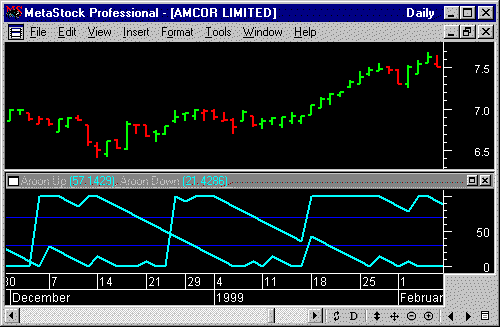|
Aroon

Description
The Aroon
indicator was developed by Tushar Chande. Aroon
is a Sanskrit word meaning “dawn’s early
light” or the change from night to
day. The Aroon indicator allows you to
anticipate changes in security prices
from trending to trading range. For more
information on the Aroon indicator see
the article written by Tushar Chande in
the September 1995 issue of
Technical Analysis of Stocks &
Commodities magazine.
These
changes are anticipated by measuring the
number of periods that have passed since
the most recent x-period high and
x-period low. Therefore, the Aroon
indicator consists of two plots; one
measuring the number of periods since
the most recent x-period high (Aroon Up)
and the other measuring the number of
periods since the most recent x-period
low (Aroon Down).
The actual
plotted value is a “stochastic” like
scale ranging from 0 to 100. Assuming a
default time-period of 14 days, if a
security makes a new 14-day high, the
Aroon Up = 100; when the security makes
a new 14-day low, the Aroon Down = 100.
When the security has not made a
new high for 14 days, the Aroon Up = 0;
when the security has not made a
new low for 14 days, the Aroon Down = 0.
As
explained in the interpretation section
for the VHF indicator
the age-old problem for many
trading systems is their inability to
determine if a trending or trading range
market is at hand. Trend-following
indicators such as MACD and moving
averages, tend to be whipsawed as
markets enter a non-trending congestion
phase. On the other hand,
overbought/oversold oscillators (which
work well during trading range markets)
tend to overreact to price pull-backs
during trending markets—thereby closing
a position prematurely. The Aroon
indicator attempts to remedy this by
helping you determine when
trend-following or overbought/oversold
indicators are likely to succeed.
Interpretation
There are
basically three conditions that you look
for when interpreting the Aroon
indicator: extremes at 0 and 100,
parallel movement between Aroon Up and
Aroon Down, and crossovers between Aroon
Up and Aroon Down.
Extremes: When the Aroon Up line
reaches 100, strength is indicated. If
the Aroon Up remains persistently
between 70 and 100, a new uptrend is
indicated. Likewise if the Aroon Down
line reaches 100, potential weakness is
indicated. If the Aroon Down remains
persistently between 70 and 100, a new
downtrend is indicated.
A strong
uptrend is indicated when the Aroon Up
line persistently remains between 70 and
100 while the Aroon Down line
persistently remains between 0 and 30.
Likewise a strong downtrend is indicated
when the Aroon Down line persistently
remains between 70 and 100 while the
Aroon Up line persistently remains
between 0 and 30.
Parallel
Movement: When the Aroon Up and
Aroon Down Lines move parallel with each
other (are roughly at the same level),
then consolidation is indicated. Expect
further consolidation until a
directional move is indicated by an
extreme level or a crossover.
Crossovers: When the Aroon Down
line crosses above the Aroon Up line,
potential weakness is indicated. Expect
prices to begin trending lower. When the
Aroon Up line crosses above the Aroon
Down line, potential strength is
indicated. Expect prices to begin
trending higher. |